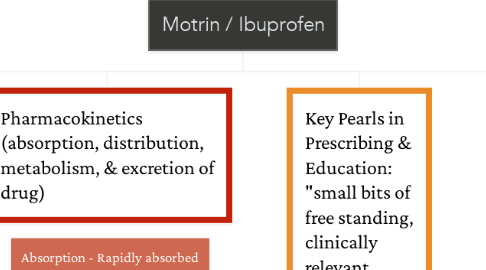Motrin / Ibuprofen
by Wendy Warren


1. Important points about the Pharmacology from both the provider & patient perspectives
1.1. Patients should inform healthcare professional if they have symptoms of heart problems or stroke, chest pain, trouble breathing weakness in one part or side of body, slurred speech, leg swelling, vomiting blood or blood in their stool.
1.2. Educate the patient on interactions: use with caution/do not not using motrin with use with other NSAIDs, narcotics with NSAIDs (such as Norco) or anticoagulants
1.3. Providers should use caution in patients with high blood pressure, heart disease, liver cirrhosis, kidney disease, or if they have hepatic or renal impairment, a bleeding disorder, or a duodenal/gastric/peptic ulcer as it may make it may worsen these conditions.
1.4. NSAIDs increase risk of serious GI adverse events, including bleeding, ulceration, and gastric or intestinal perforation
1.5. Long-term administration of NSAIDs may result in renal papillary necrosis and other renal injury.
2. Key Pearls in Prescribing & Education: "small bits of free standing, clinically relevant information based on experience or observation” (Martin et al., 2008)
2.1. Does not have effects on platelets that aspirin does
2.2. Available OTC and easily accessible for mild pains
2.3. Alternative to opioids
2.4. Have a ceiling effect (Nguyen et al., 2017)
3. Pharmacodynamics (therapeutic effects of drug)
3.1. Inhibits synthesis of prostaglandins in body tissues by inhibiting at least 2 cyclo-oxygenase (COX) isoenzymes, COX-1, COX-2
3.1.1. By stopping the creation of certain prostaglandins, which are lipids that deal with injury or illness and are active in the pathways, inflammation, pain, and fever are reduced
3.2. May inhibit chemotaxis, alter lymphocyte activity, decrease proinflammatory cytokine activity, and inhibit neutrophil aggregation; these effects may contribute to anti-inflammatory activity
3.3. Used for mild pain or fevers
4. Pharmacokinetics (absorption, distribution, metabolism, & excretion of drug)
4.1. Absorption - Rapidly absorbed (85%)
4.1.1. Bioavilability: 80 - 100%
4.1.2. Onset: 30-60 min
4.1.3. Duration 4-6 hours
4.1.4. Metabolism: Rapidly metabolized in liver (primarily by CYP2C9; CYP2C19 substrate) via oxidation to inactive metabolites
4.1.5. Distribution: protein bound 90-99%; concentrations >20mcg/mL; vd: 0.12 L/kg in adults
4.1.6. Elimination: Half-life: 2-4 hr (adults)
4.1.6.1. Urine (50-60%; <10% unchanged); remainder in feces within 24 hr

